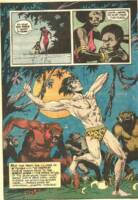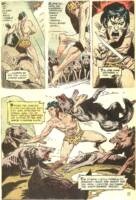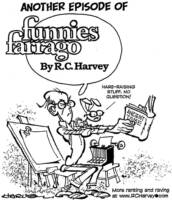Funnies Farrago on historic moments in the Tarzan comic strip.
The Tarzan we see in the funnies these days is a somewhat diminished reminder of the strip’s place in the history of comic strips. When Tarzan began in this country on January 7, 1929, it was the first serious storytelling comic strip. It established the adventure strip genre on the funnies pages of American newspapers, which, until then, had been strictly for laughs.
Well, not quite “the first” if we’re looking for solo accomplishment: Buck Rogers, which began on the same day, completed the historic occasion by looking seriously at outer space instead of into jungles. So Buck Rogers stood with Tarzan in the doorway leading to a host of serious continuity comic strips in the 1930s.
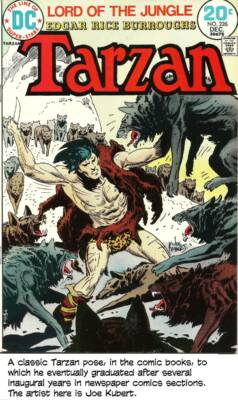 Apart from setting, the two strips differed in format. Buck Rogers followed the established comic strip form—a sequence of panels in which characters spoke in speech balloons.
Apart from setting, the two strips differed in format. Buck Rogers followed the established comic strip form—a sequence of panels in which characters spoke in speech balloons.
Tarzan, however, was different. Although it appeared in “strip” form, there were no speech balloons. Instead, the pictorial panels were accompanied by prose narrative text that appeared beneath the panels. This form had been developed for publication in book form, not in newspapers. When the book didn’t sell very well, the strips were re-arranged in daily segments and the resulting “comic strip” was marketed as a comic strip feature. And as such, it was very successful, particularly when it graduated from daily black-and-white to Sunday color.
Now, 92 years later, Tarzan is being retired as a syndicated comic strip according to D. D. Degg at the DailyCartoonist.com on April 17. Andrews McMeel Syndication (AMS) has confirmed that it will halt distribution on June 20, 2021.
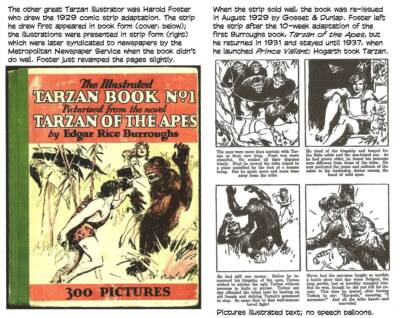 For decades Tarzan has been in rerun status — the dailies since 1972, the Sundays since 2002 — now even those will no longer be offered to newspapers.
For decades Tarzan has been in rerun status — the dailies since 1972, the Sundays since 2002 — now even those will no longer be offered to newspapers.
When asked the reasons for ending syndication, AMS comics editor Shena Wolf replied that the decision was “based on the very small client list (as you suspected) and content concerns that come with running a comic that was made nearly one hundred years ago.”
The content problems with the strip are obvious. The daily comic strips being rerun now are from the early 1950s. Even the Sundays, currently from 1980 (and by recognized comics geniuses Archie Goodwin and Gil Kane), are not sensitive to today’s culture.
But no matter how well done the White Man’s Burden aspect of Edgar Rice Burroughs’ English lord being King of the Jungle, it is hard to ignore in these “woke” days. Which is why the GoComics Tarzan page includes this notice (in italics):
This historic comic is presented in its original form, unedited from the time period in which it was created. These images may contain harmful stereotypes, problematic and antiquated ideologies, or otherwise negative cultural depictions and themes indicative of the context in which it first appeared. We run these vintage comic strips to preserve a digital archive of the medium’s early examples.
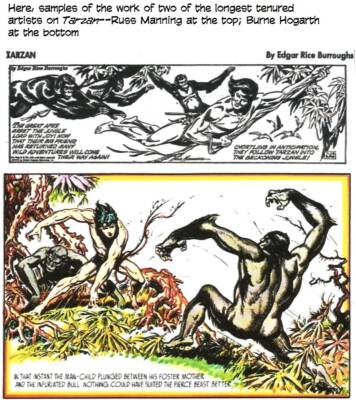 The Tarzan comic strip, during its run, has benefited from the service of acknowledged Masters of Comic Art. Along with the aforementioned Goodwin and Kane there was Harold Foster, Burne Hogarth, and Russ Manning. Also contributing were top of the line comic illustrators like Dan Barry, Nick Cardy, Bob Lubbers, Gray Morrow, Mike Grell, Joe Kubert, and others.
The Tarzan comic strip, during its run, has benefited from the service of acknowledged Masters of Comic Art. Along with the aforementioned Goodwin and Kane there was Harold Foster, Burne Hogarth, and Russ Manning. Also contributing were top of the line comic illustrators like Dan Barry, Nick Cardy, Bob Lubbers, Gray Morrow, Mike Grell, Joe Kubert, and others.
It is not known if the 25-year archive will remain up at GoComics, or if Edgar Rice Burroughs Inc. will shop a Tarzan comic strip to other syndicates.
Below is the full statement (in italics) from ERB Inc. President Jim Sullos regarding the syndication ending of the Tarzan comic strip as released to The Daily Cartoonist.
Tarzan has proven to be a timeless character, maintaining his perennial qualities of strength, courage, protector of wildlife and the environment, and defender of those in need, even as he adapts to the changing world. Every generation has its Tarzan, and its own way of experiencing the ape-man’s adventures, and this generation is no different.
Tarzan sprang to life from the pages of a pulp magazine over 100 years ago, and soon after became a worldwide best-seller in book publishing. With the rise of silent films, he became an international star on the big screen, the world’s first superhero; when the “talkies” arrived in the theaters, Tarzan came and conquered.
Next were the newspaper strips and comic books, and later 2D video games, and most recently a 3D virtual reality video game where players can “become” Tarzan themselves. Whenever the entertainment media develops its next innovation, there is Tarzan.
We are extremely proud of Tarzan’s 92-year run in the print newspaper strips, which is a testament to his enduring nature. As forms of media change over the years, Tarzan adapts as he always has and as we have always anticipated. Therefore, nearly a decade ago, we transitioned the Tarzan comic strips to our robust online comics program at edgarriceburroughs.com/comics, where we have enlisted a creative team of major industry talents such as Roy Thomas and Thomas Grindberg to continue the legendary ape-man’s all-new exploits.
These webcomics are the direct continuation of the print Tarzan newspaper strips, with the first online strip of “THE NEW ADVENTURES OF TARZAN” being labeled #3693, picking up the numbering sequence uninterrupted from the last original Tarzan Sunday newspaper strip in 2002.
Dark Horse Comics will be publishing graphic novel collections of both “THE NEW ADVENTURES OF TARZAN” and another of our Tarzan online comic strips, “TARZAN OF THE APES: A CLASSIC ADAPTATION,” by Roy Thomas, Pablo Marcos, and Oscar Gonzales.
In addition to these two Tarzan comics, our online program also includes 24 more storylines adapted from among the 80+ books written by Edgar Rice Burroughs, and a number of these webcomics are also available in the Spanish language.
Tarzan continues to thrive in the twenty-first century, adapting as he always has, with new online comics as well as video games, novels, merchandise, and other exciting entertainment media projects that are in development.
We conclude our memorial with a few comic book pages drawn by Joe Kubert, another of the Tarzan masters.
- Funnies Farrago Celebrates a Half Century of Doonesbury - June 1, 2022
- Who Really Invented the Comic Character ‘Archie’? - May 7, 2022
- Dick Wright Returns - April 5, 2022

